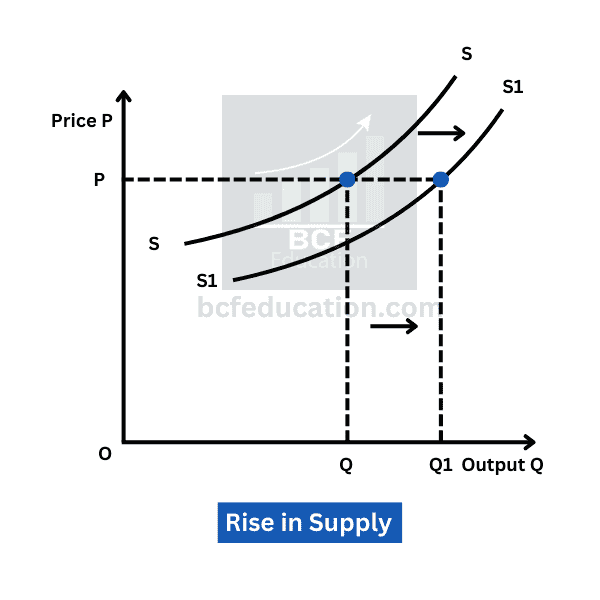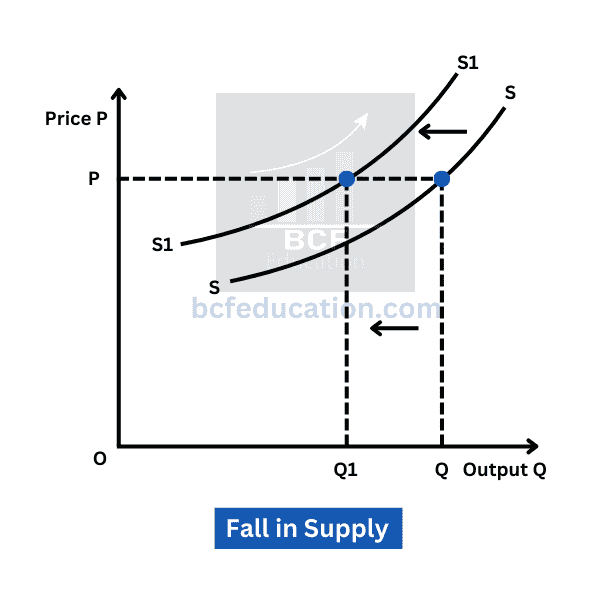Explore the concepts of Extension and Contraction as well as Rise and Fall in Supply—key principles in economics that help understand how supply reacts to price changes and other factors. This blog post breaks down these concepts, illustrating their significance with clear examples and diagrams. Perfect for economics, business, and finance students seeking to master the dynamics of supply in the marketplace. This topic is equally important for the students of economics across all the major Boards and Universities such as FBISE, BISERWP, BISELHR, MU, DU, PU, NCERT, CBSE & others & across all the business & finance disciplines.
Table of Contents
Extension and Contraction, Rise and Fall in Supply
Extension and Contraction of Supply/Movement along the Supply Curve
Other factors remaining constant, the change in quantity supply of a product with respect to change in price of a product is called extension and contraction of a supply or movement along the supply curve.
P↑Q.S↑ P↓ Q.S↓, Ceteris Paribus
Here ceteris paribus means, all other factor remaining constant except price.
- Extension of supply means, the increase of quantity supply Q.s due to increase in price of that product p.
- Contraction of supply means, the decrease of quantity supply Q.s due to decrease in price of that product p.
Now we are going to explain extension and contraction of supply with the help of table and diagrams given below:
Table 4.2 a Extension of Supply
| Q.S (X) | P(x) |
| 100 | 10 |
| 200 | 20 |
Figure 4.2 a Extension of Supply

Explanation
Extension of supply always remains along the supply line. It moves upward right on the supply line. As it is shown in above figure that when price of the product is 10, its quantity supply is 100 units. When price increases from 10 to 20, its quantity supply also increases from 100 to 200.
Table 4.2 b Contraction of Supply
| Q.S (X) | P(x) |
| 200 | 20 |
| 100 | 10 |
Figure 4.2 b Contraction of Supply

Explanation
Contraction of supply always remains along the supply line. It moves downward left on the supply line. As it is shown in above figure that when price of the product is 20, its quantity supply is 200 units. When price decreases from 20 to 10, its quantity supply also decreases from 200 to 100.

Rise and Fall of Supply/Shift in Supply Curve
If the change in quantity supply either positive or negative is not due to price but other factors such as future expectations, factor costs, increase in suppliers etc. is called rise and fall in the supply. We are going to explain further below:
4.2.c Rise in Supply
When suppliers are willing to supply more goods and services at the same constant given price level due to factors other than price, it is called rise in supply. Other factors are such as technological advancements, reduction in cost, Government policies, favourable weather, increase in suppliers and future expectations of low price etc. In the rise in supply, supply curve shifts rightward as it is explained in the diagram given below:
Figure 4.2.c Rise in Supply

Explanation
Output Q is taken on x-axis and price is on y-axis. Price remains constant and supply of output is increased from Q to Q1 and supply curve shifts rightward from S to S1.
4.2.d Fall in Supply
When suppliers are willing to supply less goods and services at the same constant given price level due to factors other than price, it is called fall in supply. Other factors are such as technological setbacks, increase in cost, Unfavourable Government policies, Unfavourable weather, decrease in suppliers, natural disasters and future expectations of high price etc. In the case of fall in supply, supply curve shifts leftward as it is explained in the diagram given below:
Figure 4.2.d Fall in Supply

Explanation
Output Q is taken on x-axis and price is on y-axis. Price remains constant and supply of output is decreased from Q to Q1 and supply curve shifts leftward from S to S1.
Related Posts
Evolving different thoughts of Economics
2.1 Theory of Consumer Behaviour
2.2 Total Utility, Marginal Utility, Point of Satiety & Types of Utilities
2.3 The Law of Diminishing Marginal Utility DMU
2.4 The Law of Equal Marginal Utility EMU
3.1 Demand, Individual Demand, Aggregate Demand, Law of Demand
3.2 Change and Shift in Demand, Extension and Contraction in Demand, Rise and Fall in Demand
3.4 Point and Arc Elasticity of Demand





